How to open a cosmetic brand?
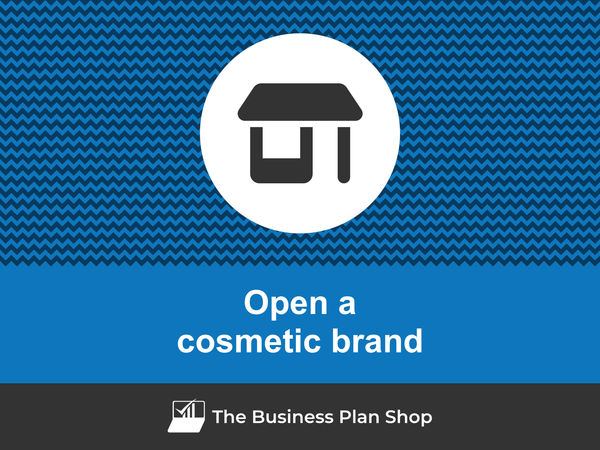
Want to start a cosmetic brand but don't know where to begin? Then you've come to the right place!
Our comprehensive guide covers everything related to opening a cosmetic brand - from choosing the right concept to setting out your marketing plan and financing your business.
You'll also learn how to assess the profitability of your business idea and decide whether or not it can be viable from a financial perspective.
Ready to kickstart your entrepreneurial journey? Let's begin!
Understanding how a cosmetic brand works
The very first step when exploring a business idea such as starting a cosmetic brand is to make sure you understand how the business operates and makes money (which is what we call the business model).
This will not only give you an initial idea of how profitable the business can be, but it will also enable you to make sure that this is the right business idea for you, given your skills, start-up capital and family or personal lifestyle, in particular.
The best ways to get to grips with the cosmetic brand's business model are to:
- Talk to cosmetic brand owners with experience
- Work a few months in a cosmetic brand already in operation
- Take a training course
Talk to cosmetic brand owners with experience
Experienced cosmetic brand owners have valuable insights and can provide practical advice based on their firsthand experiences.
They've likely encountered and overcome challenges that a newcomer might not anticipate. Learning from other’s mistakes can save you both time and money and potentially increase your venture’s chances of succeeding.
Work a few months in a cosmetic brand already in operation
Obtaining work experience in the industry can be a crucial factor in confirming whether you truly want to start a cosmetic brand, as it provides insight into the day-to-day activities.
For instance, if the working hours are longer than expected or if other business requirements don't align with your personal lifestyle or preferences, you might reconsider your entrepreneurial goals.
Even if you've decided that this business idea is a good fit for you, gaining work experience will still be valuable. It helps you better understand your target market and customer needs, which is likely to be beneficial when launching your own cosmetic brand.
Take a training course
Obtaining training within your chosen industry is another way to get a feel for how a cosmetic brand works before deciding to pursue a new venture.
Whatever approach you choose to familiarise yourself with the business, before going any further with your plans to open a cosmetic brand, make sure you understand:
- What skills are required to run the business (compare this with your own skills)
- What a typical week in the business is like (compare this with your personal or family life)
- What is the potential turnover of a cosmetic brand and the long-term growth prospects (compare this with your level of ambition)
- Your options once you decide to sell the business or retire (it's never too early to consider your exit)
Assemble your cosmetic brand's founding team
The next step to start your cosmetic brand is to think about the ideal founding team, or to go in alone (which is always an option).
Setting up a business with several partners is a way of reducing the (high) risk of launching a cosmetic brand since it allows the financial risk of the project to be shared between the co-founders.
This also allows the company to benefit from a greater diversity of profiles in the management team and to spread the burden of decision-making over several shoulders.
But, running a business with multiple co-founders brings its own challenges. Disagreements between co-founders are quite common, and these can pose risks to the business. That's why it's crucial to consider all aspects before starting your business.
To make an informed decision, we suggest asking yourself these questions:
- How many co-founders would increase the project's chances of success?
- Do you and your potential partners share the same aspirations for the project?
- What is your plan B in case of failure?
Let's examine each of these questions in detail.
How many co-founders would increase the project's chances of success?
The answer to this question will depend on a number of factors, including:
- Your savings compared with the amount of initial capital needed to launch the cosmetic brand
- The skills you have compared with those needed to make a success of such a project
- How you want key decisions to be taken in the business (an odd number of partners or a majority partner is generally recommended to avoid deadlock)
Put simply, your partners contribute money and/or skills, and increasing the number of partners is often a good idea when one of these resources is in short supply.
Do you and your potential partners share the same aspirations for the project?
One of the key questions when selecting your potential partners will be their expectations. Do you want to create a small or large business? What are your ambitions for the next 10 or 15 years?
It's better to agree from the outset on what you want to create to avoid disagreements, and to check that you stay on the same wavelength as the project progresses to avoid frustration.
What is your plan B in case of failure?
Of course, we wish you every success, but it's wise to have a plan B when setting up a business.
How you handle the possibility of things not working out can depend a lot on the kind of relationship you have with your co-founders (like being a close friend, spouse, former colleague, etc.) and each person's individual situation.
Take, for instance, launching a business with your spouse. It may seem like a great plan, but if the business doesn't succeed, you could find yourself losing the entire household income at once, and that could be quite a nerve-wracking situation.
Similarly, starting a business partnership with a friend has its challenges. If the business doesn't work out or if tough decisions need to be made, it could strain the friendship.
It's essential to carefully evaluate your options before starting up to ensure you're well-prepared for any potential outcomes.
Undertake market research for a cosmetic brand
The next step to start your cosmetic brand is to use market research to check that there is indeed an opportunity to be seized. Let's take a look at what this involves.
The objectives of market research
In a nutshell, doing market research enables you to verify that there is a business opportunity for your company to seize, and to size the opportunity precisely.
First of all, market research enables you to assess whether the market you're targeting is large enough to withstand the arrival of a new competitor: your cosmetic brand.
The market analysis will also help you define the product and service offering of your cosmetic brand, and transcribe it into a market positioning and concept that will strike a chord with your target customers.
Finally, your market research will provide you with the data you need to draw up your sales and marketing plan and estimate the revenue potential of your cosmetic brand.
Analyse key trends in the industry
Market research for a cosmetic brand must always begin with a thorough investigation of consumer habits and current industry trends.
Normally, cosmetic brand market research begins with a sectorial analysis which will provide you with a better understanding of how the industry is organized, who the major players are, and what are the current market trends.
Assess the demand
A demand analysis enables you to accurately assess the expectations of your cosmetic brand's future customers.
Your analysis will focus on the following questions:
- How many potential customers are present in the geographical areas served by your company?
- What are their expectations and purchasing behaviors?
- How much are they willing to spend?
- Are there different customer segments with distinct characteristics?
- How to communicate and where to promote your business to reach your target market?
The main goal of your demand analysis is to identify potential customer segments that your cosmetic brand could target and what products or services would meet these customers' expectations.
Supply side
Supply-side analysis looks at the products and services offered by your competitors on the market.
You should focus here on the following questions:
- Who will your competitors be?
- Are they any good?
- Where are they located?
- Who do they target?
- What range of products and services do they offer?
- Are they small independent players?
- What prices do they charge?
- How do they sell their products and services?
- Do their concepts appeal to customers?
One of the aims of your supply-side analysis will be to gather the elements that will enable you to define a market positioning that will set you apart from what is already being done on the market, so as to avoid direct confrontation with competitors already established (more on that below).
Regulations
Market research is also an opportunity to look at the regulations and conditions required to do business.
You should ask yourself the following questions:
- Does it take a specific degree to open a cosmetic brand?
- Do you need specific licences or business permits?
- What are the main regulations applicable to your future business?
Given that your project is still in its early stages, your analysis of the regulation can be carried out at a high level for the time being. You just want to identify the main laws applicable and check that you meet the conditions for running this type of business before going any further.
Once your project is more advanced, you can come back to the regulation in greater detail with your lawyer.
Concluding your market research
Your market research should lead you to draw a clear conclusion about your chances of commercial success of your business idea:
- Either the market is saturated, and you'd better look into another business idea.
- Or there's an opportunity to be seized in the geographical area you're considering, and you can go ahead with your project to open a cosmetic brand.
Choosing the right concept and positioning for your cosmetic brand
Once your market research is completed, it's time to consider the type of cosmetic brand you want to open and define precisely your company's market positioning in order to capitalise on the opportunity you identified during your market research.
Market positioning refers to the place your product and service offering occupies in customers' minds and how they differ from competing products and services. Being perceived as the premium solution, for example.
There are four questions you need to consider:
- How will you compete with and differentiate yourself from competitors already on the market?
- Is it better to start or buy a cosmetic brand already in operation?
- How will you validate your concept and market positioning?
Let's look at each of these in a little more detail.
How will you compete with and differentiate yourself from competitors already on the market?
When you choose to start up a cosmetic brand, you are at a disadvantage compared to your rivals who have an established presence on the market.
Your competitors have a reputation, a loyal customer base and a solid team already in place, whereas you're starting from scratch...
Entering the market and taking market share from your competitors won't happen automatically, so it's important to carefully consider how you plan to establish your presence.
There are four questions to consider here:
- Can you avoid direct competition by targeting a customer segment that is currently poorly served by other players in the market?
- Can you offer something unique or complementary to what is already available on the market?
- How will you build a sustainable competitive advantage for your cosmetic brand?
- Do you have the resources to compete with well-established competitors on your own, or would it be wiser to explore alternative options?
Also, think about how your competitors will react to your arrival in their market.
Is it better to start or buy a cosmetic brand already in operation?
An alternative to opening a new business is to take over a cosmetic brand already trading.
Purchasing an existing cosmetic brand means you get a loyal customer base and an efficient team. It also avoids disrupting the equilibrium in the market by introducing a new player.
A takeover hugely reduces the risk of the business failing compared to starting a new business, whilst giving you the freedom to change the market positioning of the business taken over if you wish.
This makes buying an existing cosmetic brand a solid alternative to opening your own.
However, buying a business requires more capital compared to starting a cosmetic brand from scratch, as you will need to purchase the business from its current owner.
How will you validate your concept and market positioning?
Regardless of how you choose to establish your business, it's crucial to make sure that the way you position your company aligns with the expectations of your target market.
To achieve this, you'll have to meet with your potential customers to showcase your products or services and get their feedback.
Explore the ideal location to start your cosmetic brand
The next stage in our guide on how to start a cosmetic brand: choosing where to set up shop.
Setting up your business in the right location will have a direct impact on your chances of success, so it's a good idea to think things through before you launch.
To help you decide where to set up your business, we recommend considering the following factors:
These criteria will need to be refined according to the specific features of your project.
After weighing the factors mentioned earlier, it's crucial to focus on your startup's budget. Look for a location that suits your business needs while being affordable, especially in the short term.
One of the issues that will also come up is the long-term future of your location, particularly if you opt to rent your premises rather than buy. In this case, you will need to consider the conditions for renewing the lease (duration, rent increases, etc.).
Lease agreements vary widely from country to country, so make sure you check the terms applicable to your situation and have your lawyer review your lease before you sign.
Choosing your cosmetic brand's legal form
The next step to open a cosmetic brand is to choose the legal form of your business.
The legal form of a business simply means the legal structure it operates under. This structure outlines how the business is set up and defines its legal obligations and responsibilities.
Why is your cosmetic brand's legal form important?
Choosing the legal form for your cosmetic brand is an important decision because this will affect your tax obligations, your personal exposure to risk, how decisions are made within the business, the sources of financing available to you, and the amount of paperwork and legal formalities, amongst other things.
The way you set up your business legally will impact your taxes and social contributions, both at a personal level (how much your income is taxed) and at the business level (how much the business's profits are taxed).
Your personal exposure to risk as a business owner also varies based on the legal form of your business. Certain legal forms have a legal personality (also called corporate personality), which means that the business obtains a legal entity which is separate from the owners and the people running it. To put it simply, if something goes wrong with a customer or competitor, for example, with a corporate personality the business gets sued, whereas without it is the entrepreneur personally.
Similarly, some legal forms benefit from limited liability. With a limited liability the maximum you can lose if the business fails is what you invested. Your personal assets are not at risk. However, not all structures protect you in such a way, some structures may expose your personal assets (for example, your creditors might try to go after your house if the business incurs debts and then goes under without being able to repay what it owed).
How decisions are made within the business is also influenced by the legal form of your cosmetic brand, and so is the amount of paperwork and legal formalities: do you need to hold general assemblies, to produce annual accounts, to get the accounts audited, etc.
The legal form also influences what sources of financing are available to you. Raising capital from investors requires having a company set up, and they will expect limited liability and corporate personality.
What are the most common legal structures?
It's important to note that the actual names of legal structures for businesses vary from country to country.
But they usually fall within two main types of structures:
- Individual businesses
- Companies
Individual businesses
Individual businesses, such as sole traders or sole proprietorships, are legal structures with basic administrative requirements.
They primarily serve self-employed individuals and freelancers rather than businesses with employees.
The main downside of being a sole trader is that there's usually no legal separation between the business and the person running it. Everything the person owns personally is tied up with the business, which can be risky.
This means that if there are problems or the business goes bankrupt, the entrepreneur's personal assets could be taken by creditors. So, there's a risk of personal liability in case of disputes or financial issues.
It is also not possible to raise equity from investors with these structures as there is no share capital.
Despite the downsides, being a sole proprietorship has some advantages. There is usually very little paperwork to get started, simpler tax calculations and accounting formalities.
Companies
Companies are all rounders which can be set up by one or more individuals, working on their own or with many employees.
They are recognized as a distinct entity with their own legal personality, and the liability is usually limited to the amount invested by the owners (co-founders and investors). This means that you cannot lose more than you have invested in the business.
This separation ensures that in legal disputes or bankruptcy, the company bears primary responsibility, protecting the personal assets of the founder(s) and potential investor(s).
How should I choose my cosmetic brand's legal structure?
Deciding on the legal structure is usually quite straightforward once you know how many co-founders you'll have, whether you'll have employees, and the expected revenues for the business.
A good business idea will be viable whatever the legal form you choose. How businesses are taxed changes every year, therefore one cannot rely on specific tax benefits tied to a particular structure when deciding to go into business.
One easy way to proceed is to take note of the legal structures used by your top five competitors, and assume you're going with the most commonly chosen option. Once your idea is mature and you're prepared to formally register the business, you can validate this assumption with a lawyer and an accountant.
Can I switch my cosmetic brand's legal structure if I get it wrong?
You can switch your legal setup later on, even if it involves selling the old one to a new entity in some cases. However, this comes with extra costs, so it's better to make the right choice from the beginning if you can.
How much money do I need to start a cosmetic brand?
To answer this key question, we first need to look at the resources you'll need to launch your cosmetic brand and keep it running on a daily basis. Let's take a look at what that entails.
Since each venture is distinct, providing an average budget for starting a cosmetic brand is impossible.
We strongly advise careful consideration when reading estimates on the web. It’s best to ask yourself the following questions:
- Is my project similar (location, concept, planned size, etc.)?
- Can I trust where this information is coming from?
- Is the data fresh or stale?
Your thinking behind the investments and human resources required to launch and operate the business will then enable you to cost each item and include them in your financial forecast (which we'll look at later in this guide).
Once complete, the forecast will give you a precise idea of the initial investment required and profitability potential for your business idea.
Startup costs and investments to start a cosmetic brand
Let's start with the investments. To set up a cosmetic brand, initial working capital and investments can include the following items:
- Equipment: This includes items such as cosmetic manufacturing machines, packaging equipment, and filling machines. These are essential for producing and packaging your cosmetic products.
- Inventory: As a cosmetic brand, you will need to purchase raw materials and ingredients for your products. This can include items such as essential oils, pigments, and containers.
- Facility: You will need a space to manufacture, store, and ship your cosmetic products. This could include costs for renting or purchasing a manufacturing facility, warehouse space, and office space.
- Furniture and Fixtures: To create an aesthetically pleasing and functional workspace, you may need to purchase furniture and fixtures such as desks, chairs, shelves, and display cases. These will also add to the overall branding and image of your cosmetic brand.
- Packaging and Labeling: As a cosmetic brand, packaging and labeling are crucial for your products. You may need to invest in design services, printing equipment, and packaging materials to create attractive and informative packaging for your products.
Of course, you will need to adapt this list to your company's specific needs.
Staffing requirements to operate a cosmetic brand
You'll also need to think about the staff required to run the business on a day-to-day basis.
The human resources required will vary according to the size of your company.
Once again, this list is only indicative and will need to be adjusted according to the specifics of your cosmetic brand.
Operating expenses of a cosmetic brand
The final point to consider when analyzing the resources required is the question of operating costs.
Operating expenses for a cosmetic brand may include:
- Staff costs: This includes salaries, wages, and benefits for your employees, including sales associates, makeup artists, and administrative staff.
- Accountancy fees: You may need to hire an accountant or bookkeeper to manage your financial records, prepare tax returns, and provide financial advice.
- Insurance costs: As a cosmetic brand, you may need insurance coverage for product liability, general liability, and property damage.
- Software licences: You may need to purchase or renew licences for software programs such as inventory management, point-of-sale systems, and marketing tools.
- Marketing and advertising costs: This includes expenses for social media advertising, influencer collaborations, and print or digital advertisements.
- Packaging and labeling costs: You will need to invest in packaging materials and design, as well as labels and stickers for your products.
- Research and development: To stay competitive, you may need to invest in researching and developing new products or improving existing ones.
- Raw materials and ingredients: This includes the cost of purchasing ingredients for your cosmetic products, such as oils, pigments, and fragrances.
- Shipping and logistics: You will need to cover the cost of shipping your products to customers, as well as receiving and storing inventory.
- Rent or lease: If you have a physical storefront or office space, you will need to pay rent or lease fees.
- Utilities: This includes electricity, water, and gas for your business location.
- Professional fees: You may need to hire lawyers, consultants, or other professionals for legal or business advice.
- Training and education: To keep your team up-to-date on industry trends and techniques, you may need to invest in training and education programs.
- Banking fees: This includes fees for merchant services, wire transfers, and other banking services.
- Travel expenses: If you attend trade shows or conferences, you will need to cover the cost of travel and accommodations.
Here also, this list will need to be tailored to the specifics of your cosmetic brand but should be a good starting point for your budget.
Create a sales & marketing plan for your cosmetic brand
The next step to launching your cosmetic brand is to think about the actions you need to take to promote your products and services and build customer loyalty.
Here, you'll be looking at the following issues:
- What is the best method to attract as many new customers as possible?
- How to build customer loyalty and spread word of mouth?
- What human and financial resources will be required to implement the planned actions?
- What level of sales can I expect to generate in return?
The precise sales and marketing levers to activate will depend on the size of your cosmetic brand. But you could potentially leverage some of the initiatives below.
Besides your sales and marketing plan, your sales forecast will be affected by seasonal patterns related to the nature of your business, such as fluctuations during the holiday season, and your competitive landscape.
Build your cosmetic brand's financial forecast
The next step to start your cosmetic brand: putting your financial projections together.
What is the financial forecast for a cosmetic brand?
A forecast is a quantified decision-making document that shows the initial investment required to open a cosmetic brand and the company's potential profitability and cash flow generation over the next 3 to 5 years.
As you think about your cosmetic brand idea, the main role of financial projections will be to help you decide whether it makes sense to create the company.
Building a financial forecast helps determine the amount of initial financing required to start your cosmetic brand.
In fact, creating financial projections is the only way to assess the amount of initial financing you'll need to open your cosmetic brand, and to make sure your project makes economic and financial sense.
Keep in mind that very few business ideas are financially viable. At The Business Plan Shop, we've seen nearly a million business start-up ideas, and we estimate that less than one in four is economically viable.
Your forecast will therefore require your full attention and constant revision, as your project matures. It's also a good idea to simulate different scenarios to anticipate several possibilities (what happens if your sales take longer than expected to ramp up, for example), so you're ready for all eventualities.
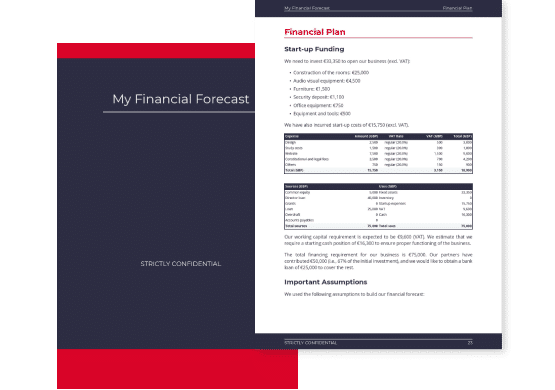
When seeking financing, your forecast will be incorporated into your business plan, which is the document you will use to present your business idea to financial partners. We'll come back to the business plan in more detail later in this guide.
Creating and updating your cosmetic brand's forecast is an ongoing process. Indeed, having up-to-date financial projections is the only way to maintain visibility over your company's future cash flow and cash position.
Forecasting is, therefore, the financial management tool that will be with you throughout the life of your company. Once you've started trading, you'll need to regularly compare the difference between your actual accounts and your forecasts, and then adjust them to maintain visibility over your future cash flows.
What does a financial projection look like?
The following financial tables will be used to present your cosmetic brand's financial forecast.
The projected P&L statement
Your cosmetic brand's forecasted P&L statement will enable you to visualise your cosmetic brand's expected growth and profitability over the next three to five years.
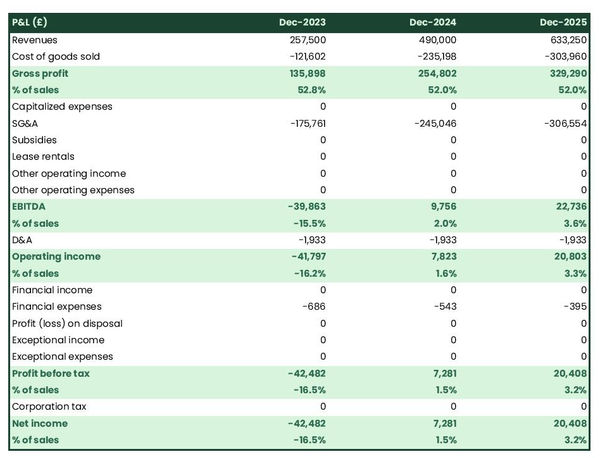
The projected balance sheet of your cosmetic brand
The projected balance sheet gives an overview of your cosmetic brand's financial structure at the end of the financial year.
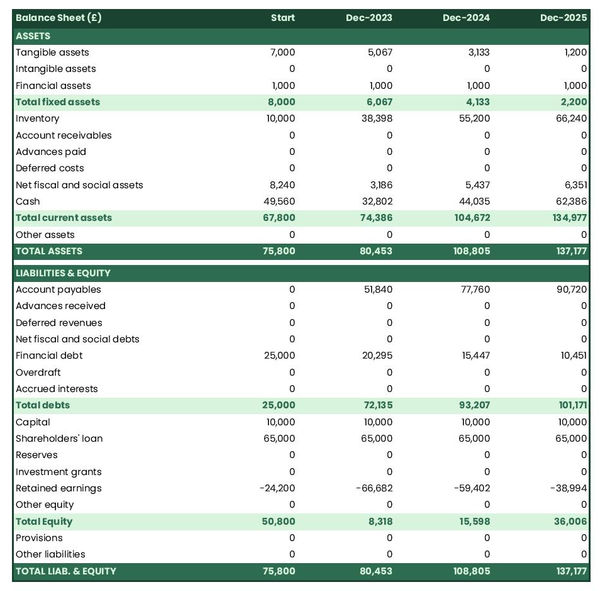
The cash flow projection
A cash flow forecast for a cosmetic brand shows the projected inflows and outflows of cash over a specific period, providing insights into liquidity and financial health.
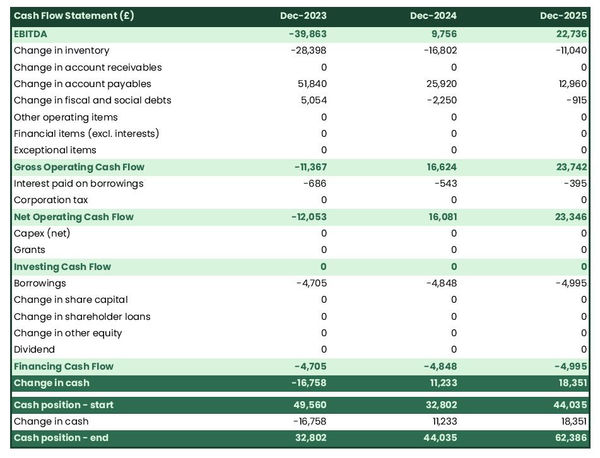
Which solution should you use to make a financial projection for your cosmetic brand?
Using an online financial forecasting tool, such as the one we offer at The Business Plan Shop, is the simplest and safest solution for forecasting your cosmetic brand.
There are several advantages to using specialised software:
- You can easily create your financial forecast by letting the software take care of the financial calculations for you without errors
- You have access to complete financial forecast templates
- You get a complete financial forecast ready to be sent to your bank or investors
- The software helps you identify and correct any inconsistencies in your figures
- You can create scenarios to stress-test your forecast's main assumptions to stress-test the robustness of your business model
- After you start trading, you can easily track your actual financial performance against your financial forecast, and recalibrate your forecast to maintain visibility on your future cash flows
- You have a friendly support team on standby to assist you when you are stuck
If you are interested in this type of solution, you can try our forecasting software for free by signing up here.
How do I choose a name and register my cosmetic brand?
Now that your project of launching a cosmetic brand is starting to take shape, it's time to look at the name of your business.
Finding the name itself is generally fairly easy. The difficulty lies in registering it.
To prevent this guide from being too long, we won't go into all the criteria you need to take into account when choosing a striking name for your cosmetic brand. However, try to choose a name that is short and distinctive.
Once you have a name that you like, you need to check that it is available, because you cannot use a name that is identical or similar to that of a competitor: this type of parasitic behaviour is an act of unfair competition for which you risk being taken to court by your competitors.
To avoid any problems, you will need to check the availability of the name:
- Your country's company register
- With the trademark register
- With a domain name reservation company such as GoDaddy
- On an Internet search engine
If the desired name is available, you can start the registration process.
It is common to want to use the trading name as the name of the company, and to have a domain name and a registered trademark that also correspond to this name: Example ® (trading name protected by a registered trademark), Example LTD (legal name of the company), example.com (domain name used by the company).
The problem is that each of these names has to be registered with a different entity, and each entity has its own deadlines:
- Registering a domain name is immediate
- Registering a trademark usually takes at least 3 months (if your application is accepted)
- The time taken to register a new business depends on the country, but it's generally quite fast
How do I go about it?
Well, you have two choices:
- Complete all registrations at the same time and cross your fingers for a smooth process.
- Make sure to secure the domain names and trademarks. Once that's done, wait for confirmation of a successful trademark registration before moving on to register the company.
At The Business Plan Shop, we believe it's essential to prioritize securing your domain names and trademarks over the business name. This is because you have the flexibility to use a different trading name than your legal business name if needed.
Regardless, we suggest discussing this matter with your lawyer (see below in this guide) before making any decisions.
Deciding upon the corporate identity of your cosmetic brand
The next step in opening a cosmetic brand is to look at your company's visual identity.
Your company's “visual identity” plays a crucial role in shaping your brand image. It helps you to be recognizable and to stand out from your competitors.
Although you can define your visual identity yourself, it is generally advisable to call on the services of a designer or marketing agency to achieve a professional result.
At a minimum, you will need to define the following elements:
- Logo
- Brand guidelines
- Business cards
- Website theme
Logo
Your cosmetic brand's logo allows others to quickly identify your company. It will be used on all your communication media (website, social networks, business cards, etc.) and official documents (invoices, contracts, etc.).
In addition to its design, it's important that your logo is available in a variety of colors, so that it can be seen on all media (white, dark background, etc.).
Brand guidelines
Having brand guidelines enables you to maintain consistency in formatting across all your communications media and official documents.
Brand guidelines define the font (family and size), design and colours used by your brand.
In terms of fonts, for example, you may use Roboto in size 20 for your titles and Lato in size 14 for your texts.
The colours used to represent your brand should generally be limited to five:
- The main colour,
- A secondary colour (the accent),
- A dark background colour (blue or black),
- A grey background colour (to vary from white),
- Possibly another secondary colour.
Business cards
Designing business cards for your cosmetic brand is a must, as they will allow you to communicate your contact details to your customers, suppliers, partners, potential recruits, etc.
In principle, they will include your logo and the brand guidelines that we mentioned above.
Website theme
In the same way, the theme of your cosmetic brand website will be based on your logo and the brand guidelines we mentioned above.
This involves defining the look and feel of your site's main graphic elements:
- Buttons,
- Menus,
- Forms,
- Banners,
- Etc.
Navigate the legal and regulatory requirements for launching your cosmetic brand
The next thing to do in getting a cosmetic brand off the ground is to handle all the legal and regulatory requirements. We recommend that you be accompanied by a law firm for all of the steps outlined below.
Intellectual property
One of your priorities will be to ensure that your company's intellectual property is adequately protected.
As explained before, you can choose to register a trademark. Your lawyer can help you with a detailed search to make sure your chosen trademark is unique and doesn't clash with existing ones.
They'll assist in preparing the required documents and steer you in picking the right categories and locations for trademark registration.
Moreover, your lawyer can offer guidance on additional measures to protect other intellectual property assets your company may have.
Getting your cosmetic brand paperwork in order
For day-to-day operations, your cosmetic brand will need to rely on a set of contractual documents.
Your exact needs in this respect will depend on the country in which you are launching your cosmetic brand, the number of partners and the envisaged size of the company.
However, you will probably need at least the following documents:
- Employment contracts
- General terms and conditions of sale
- General terms and conditions of use for your website
- Privacy Policy for your website
- Cookie Policy for your website
- Invoices
- Etc.
Applying for licences and permits and registering for various taxes
Operating your business legally may require licences and business permits. The exact requirements applicable to your situation will depend on the country in which you set up your cosmetic brand.
The lawyers who advise you will also be able to guide you with regard to all the rules applicable to your business.
Similarly, your accountant will be able to help you take the necessary steps to comply with the tax authorities.
Writing a business plan for your cosmetic brand
The next step in opening a cosmetic brand is to draw up your business plan.
What is a cosmetic brand's business plan?
A business plan serves as a comprehensive roadmap outlining the objectives, strategies, and key components of your venture.
There are two essential parts to a business plan:
- A numerical part, the financial forecast we mentioned earlier in this guide, which highlights the amount of initial financing needed to launch the business and its potential profitability over the next 3 to 5 years,
- A written part, which presents in detail the project of creating a cosmetic brand and provides the necessary context to enable the reader of the business plan to judge the relevance and coherence of the figures included in the forecast.
Your business plan helps guide decision-making by showcasing your vision and financial potential in a coherent manner.
Your business plan will also be essential when you're looking for financing, as your financial partners will ask you for it when deciding whether or not to finance your project to open a cosmetic brand. So it's best to produce a professional, reliable, and error-free business plan.
In essence, your business plan is the blueprint to turn your idea into a successful reality.
What tool should you use to create your cosmetic brand business plan?
If you want to write a convincing business plan quickly and efficiently, a good solution is to use an online business plan software for business start-ups like the one we offer at The Business Plan Shop.

Using The Business Plan Shop to create a business plan for a cosmetic brand has several advantages :
- You can easily create your financial forecast by letting the software take care of the financial calculations for you without errors
- You are guided through the writing process by detailed instructions and examples for each part of the plan
- You can access a library of dozens of complete startup business plan samples and templates for inspiration
- You get a professional business plan, formatted and ready to be sent to your bank or investors
- You can create scenarios to stress test your forecast's main assumptions
- You can easily track your actual financial performance against your financial forecast by importing accounting data
- You can easily update your forecast as time goes by to maintain visibility on future cash flows
- You have a friendly support team on standby to assist you when you are stuck
If you're interested in using our solution, you can try The Business Plan Shop for free by signing up here.
How to raise finance for my cosmetic brand?
Once your business plan has been drafted, you’ll need to think about how you might secure the financing necessary to open your cosmetic brand.
The amount of initial financing required will obviously depend on the size of your cosmetic brand and the country in which you wish to set up.
Businesses have access to two main categories of financing: equity and debt. Let's take a closer look at how they work and what sources are available.
Equity funding
At a high level, the equity of your cosmetic brand will consist of the money that founders and potential investors will invest to launch the company.
Equity is indispensable as it provides the company with a source of long-term (often permanent) financing and demonstrates the founders' conviction in the company's chances of success, since their investments would be lost in the event of bankruptcy.
Equity investors can generate a return on their investment through dividends (which can only be paid out if the company is profitable) or capital gains on the resale of their shares (if the company is attractive enough to attract a buyer).
As you can see, the equity investors' position is extremely risky, since their capital is at risk and can be lost in the event of bankruptcy, and the company must be profitable or resellable before they can hope to generate a return on their investment.
On the other hand, the return on investment that equity investors can expect to generate by investing in a cosmetic brand can be very substantial if the company is successful.
This is why equity investors look for start-up ideas with very high growth or profitability potential, in order to offset their risk with a high potential return on investment.
In technical terms, equity includes:
- Share capital and premiums: which represent the amount invested by the shareholders. This capital is considered permanent as it is non-refundable. In return for their investment, shareholders receive shares that entitle them to information, decision-making power (voting in general assembly), and the potential to receive a portion of any dividends distributed by the company.
- Director loans: these are examples of non-permanent capital advanced to the company by the shareholders. This is a more flexible way of injecting some liquidity into your company than doing so as you can repay director loans at any time.
- Reserves: these represent the share of profits set aside to strengthen the company's equity. Allocating a percentage of your profits to the reserves can be mandatory in certain cases (legal or statutory requirement depending on the legal form of your company). Once allocated in reserves, these profits can no longer be distributed as dividends.
- Investment grants: these represent any non-refundable amounts received by the company to help it invest in long-term assets.
- Other equity: which includes the equity items which don't fit in the other categories. Mostly convertible or derivative instruments. For a small business, it is likely that you won't have any other equity items.
The main sources of equity are as follows:
- Money put into the business from the founders' personal savings.
- Money invested by private individuals, which can include business angels, friends, and family members.
- Funds raised through crowdfunding, which can take the form of either equity or donations (often in exchange for a reward).
- Government support to start-ups, for example, loans on favourable terms to help founders build up their start-up capital.
Debt funding
The other way to finance your cosmetic brand is to borrow. From a financial point of view, the risk/return profile of debt is the opposite of that of equity: lenders' return on investment is guaranteed, but limited.
When it borrows, your company makes a contractual commitment to pay the lenders by interest, and to repay the capital borrowed according to a pre-agreed schedule.
As you can see, the lenders' return on investment is independent of whether or not the company is profitable. In fact, the only risk taken by lenders is the risk of the company going bankrupt.
To avoid this risk, lenders are very cautious, only agreeing to finance when they are convinced that the borrowing company will be able to repay them without problems.
From the point of view of the company and its stakeholders (workforce, customers, suppliers, etc.), debt increases the risk of the venture, since the company is committed to repaying the capital whether or not it is profitable. So there's a certain distrust towards heavily indebted companies.
Companies borrow in two ways:
- Against their assets: this is the most common way of borrowing. The bank finances a percentage of the price of an asset (a vehicle or a building, for example) and takes the asset as collateral. If the company cannot repay, the bank seizes the asset and sells it to limit its losses.
- Against their future cash flows: the bank reviews the company's financial forecast to estimate how much the company can comfortably borrow and repay, and what terms (amount, interest rate, term, etc.) the bank is prepared to offer given the credit risk posed by the company.
When creating a cosmetic brand, the first option is often the only one available, as lenders are often reluctant to lend on the basis of future cash flows to a structure that has no track record.
The type of assets that can be financed using the first method is also limited. Lenders will want to be sure that they can dispose of foreclosed assets if needed, so they need to be assets that have an established second-hand market.
That being said, terms and conditions also depend on the lender: some banks are prepared to finance riskier projects, and not all have the same view of your company's credit risk. It also depends on the collateral you can offer to reduce risk, and on your relationship with the bank.
In terms of possible sources of borrowing, the main sources here are banks and credit institutions.
In some countries, it's also possible to borrow from private investors (directly or via crowdlending platforms) or other companies, but not everywhere.
Takeaways on how to finance a cosmetic brand
Multiple options are available to help you raise the initial financing you need to launch your cosmetic brand.
There are two types of financing available to companies. To open a cosmetic brand, an equity investment will be required and may be supplemented by bank financing.
What to do after launching my cosmetic brand?
Launching your cosmetic brand is the beginning of an exciting entrepreneurial adventure, and the culmination of your efforts to turn your idea into a reality. But this is also when the real work begins.
As you know, nearly half of all new businesses fail, so you'll need to do everything you can to make your business sustainable right from the start.
Estimating the future financial performance of a cosmetic brand inevitably involves a degree of uncertainty. That's why we recommend simulating several scenarios: a central case with the most likely scenario, an optimistic case, and a pessimistic case designed to test the limits of your business model.
Normally, your company's actual financial performance, observed after you start trading, should fall somewhere between your pessimistic and optimistic cases.
The important thing will be to quickly measure and compare this actual performance with the figures in your forecast to see where you stand, then update the forecast to re-estimate the future cash flows and cash position of your cosmetic brand.
This forward-looking financial management exercise is the only way to know where you stand and where you're going. And, when your figures fall short of expectations, to quickly implement actions to turn things around before the company runs out of cash.
There's nothing more dangerous than waiting until you have your accounts, which takes up to nine months after the end of your financial year (if you are in the UK, abroad your mileage will vary), to then realize that you're not on the right track and that your cosmetic brand won't have enough cash to operate over the next twelve months.
This is where using a forecasting solution that integrates actuals vs. forecast tracking, like The Business Plan Shop's financial dashboards do, can simplify the financial management of your business and help reduce the risk associated with your start-up project.
Key takeaways
- To open a cosmetic brand you need to go through each of the 15 steps we have outlined in this guide.
- The financial forecast is the tool that will enable you to check that your project can be profitable and to estimate the investment and initial financing requirements.
- The business plan is the document that your financial partners will ask you to produce when seeking finance.
- Once you have started trading, it will be essential to keep your financial forecasts up to date in order to maintain visibility of the future cash flow of your cosmetic brand.
- Leveraging a financial planning and analysis platform that seamlessly integrates forecasts, business plans, and real-time performance monitoring — like The Business Plan Shop — simplifies the process and mitigates risks associated with launching a business.
We hope this practical guide has given you a better understanding of how to open a cosmetic brand. Please do not hesitate to contact our team if you have any questions or if you would like to share your experience of setting up your own business.
Also on The Business Plan Shop
Do you know someone who is thinking about opening a cosmetic brand? Share our guide with them!





